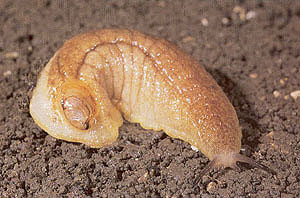The slugs in this family have a noticeable characteristic by having a little shell
on the tailend which protects the mantle cavity,the heart and the "kidney".
They are carnivorous and real predators,earthworms and other slugs are caught
between the needlike teeth of the radula.Contrary to other snails and slugs
torsion(the rotation of the intestines)has been reversed.The slugs live mostly
on disturbed(agricultural)ground,being below the surface or under stones or
leaflitter.
The one genus has three species:T.maugei(Ferussac,1819),T.haliotidea(Draparnaud,1801)
and T.scutulum(Sowerby,1820)
 T.haliotidea
Image:www.weichtiere.at
T.haliotidea
Image:www.weichtiere.at
Testacella haliotidea,Draparnaud This species can reach 12 cm when fully extended.The shell is about 8 mm x 5.5 mm, subtriangular shaped.The animal is pale brown or cream with a pale sole. The eggs are about 6 x 4 mm which hatch in circa 14 days. T.haliotidea is common in England,Wales and south of Scotland in parks and gardens. It also appears in some south-eastern and southern counties of Ireland.
Testacella maugei,Ferussac A smaller slug,6-10 cm,but with a larger shell: 15 x 7 mm.The animal is brown becoming paler towards the sole with black specks.The sole is dark or light. Internally the difference is the absence of a penial flagellum,and the origin of both cephalic retractors is on the left side. Eggs are laid from May to August,8-15 at a time,5 x 4 mm in size. These are white going to yellow and hatch in 3 to 5 weeks. Six varieties are known based on coloring. From Tangiers and Gibraltar to Dieppe(France),Azores,Canaries,Madeira,Channel Islands and Britain(Chesire to Middlesex).Also in sout-east Ireland.
Testacella scutulum,Sowerby The animal is yellowish with brown specks,and the sole and fringe orange. The shell is 7 x 4 mm. The eggs are 5 x 3 mm,white turning to brown,which hatch in 3-5 weeks. Three varieties are known:major,with a larger shell;albina,animal whitish and aurea animal orange with brown mottling.
In Algeria,Morocco,south-east Spain,west and south France,Italy,Sicily, Corsica,Sardinia,England,south Scotland and south-east Ireland. "When a Testacella has discovered the prey on which it wishes to make a repast, it moves stealthily to one side of the worm, with an indifference so complete, that one would suppose it had not observed it and disdained it; but suddenly it turns, and while the worm is twisting to the right and the left, it lifts its head, withdraws its tentacles, dilates enormously its mouth and throws itself upon its prey, enfixing it with a kind of suction".
"It deposits its eggs in the ground perfectly round at first, and nothing more than a pellicule filled with a viscid humour, but at the end of fifteen days... the humour thickens, the round form changes into an oval, and the slug hatches it like a chicken". (Reeve, L. 1863)
"The Testacella, although plentiful, is seldom seen, on account of its peculiar habits. It feeds almost wholly on earthworms, which it pursues through all the windings of their retreats, its long lithesome body enabling it to insinuate itself wherever the worm can burrow, and its hard little shell securing it from danger by stopping up the tunnel behind its progress". "The tooth-ribbon of this creature is most formidably armed, having about two thousand teeth arranged in fifty rows. The teeth are needle shaped, barbed, sharply pointed, slightly curved, and converge towards the entre of the ribbon, thus forming a weapon which no worm is capable of resisting". (Wood, 1863)
links: Testacella haliotidea Testacella...not so shy in Olney